SEVENTH GRADE MATH TUTORING
Help students master complex 7th grade math
7th graders are introduced to more advanced math concepts, word problems and math tests become more complex than 6th grade math.
But without a solid understanding of the foundations, many students struggle to master 7th grade math skills and end up falling behind.
Online 7th grade math tutoring provides extra math help for the students who need it most; the personalized math lessons boost academic success.

I’d recommend Third Space Learning because it really works. one-on-one time is invaluable with some of our students and the chance to apply their middle school math understanding and have it reinforced is vital.
Neil Straw
Perton Middle School

Benefits of online 7th grade math tutoring
Middle school math can be challenging in the 7th grade and student’s needs and math ability can differ greatly.
Online 7th grade math tutoring can help students close misconceptions with math concepts and deepen their understanding of the middle school math curriculum before the math gap widens.

Develop problem solving
Problem solving and multi-step word problems become increasingly harder throughout middle school and target students may need a tutoring program to help with test prep.
One-on-one online tutoring sessions serve as extra math classes for 7th graders struggling to keep up with more difficult math concepts that require critical thinking.

Individualized tutoring service
Often, 7th graders benefit from different teaching styles and differentiating worksheets and instruction for a whole class can be challenging.
Each student works one-on-one with a private tutor who adapts instructions and math lesson content in real-time according to the student’s needs.
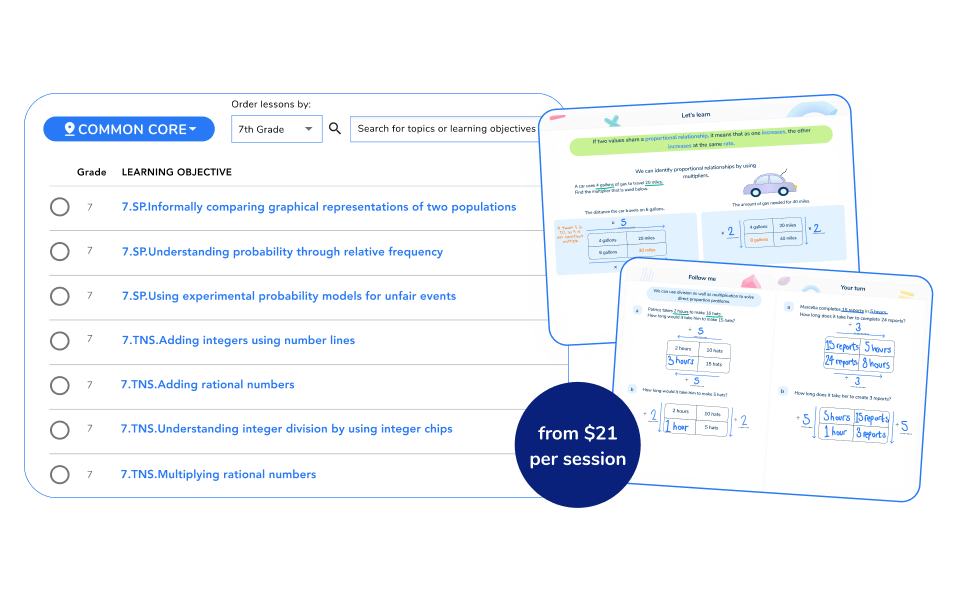
Expert 7th grade math tutoring
A team of math teachers create all math lesson plans covering the seventh grade standards for every US state and Common Core.
Third Space Learning’s expert tutors are STEM specialists, it’s like bringing in multiple high-quality interventionists into your school without the price tag.
Preview 7th grade math tutoring lessons
Preview 7th grade math tutoring lessons
Specially created lessons designed to build conceptual understanding and enable tutors to respond to students’ needs in real-time:
-
Example lesson 1
-
Example lesson 2
-
Example lesson 3
Understanding Proportional Relationships
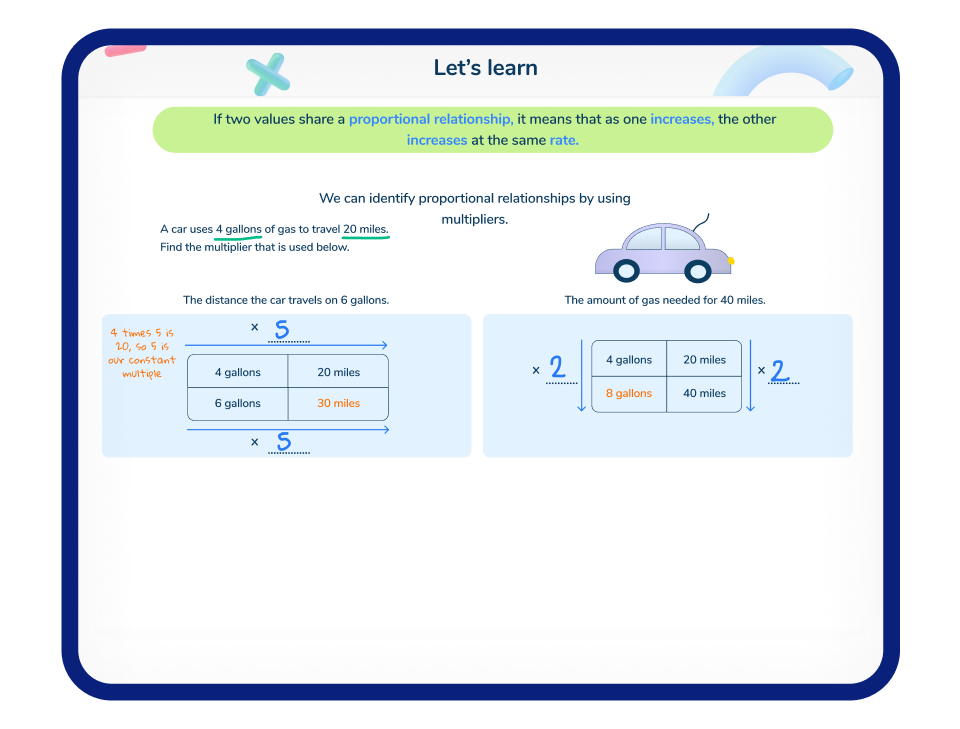
Let’s learn
The first question introduces each concept and helps students feel ready to learn
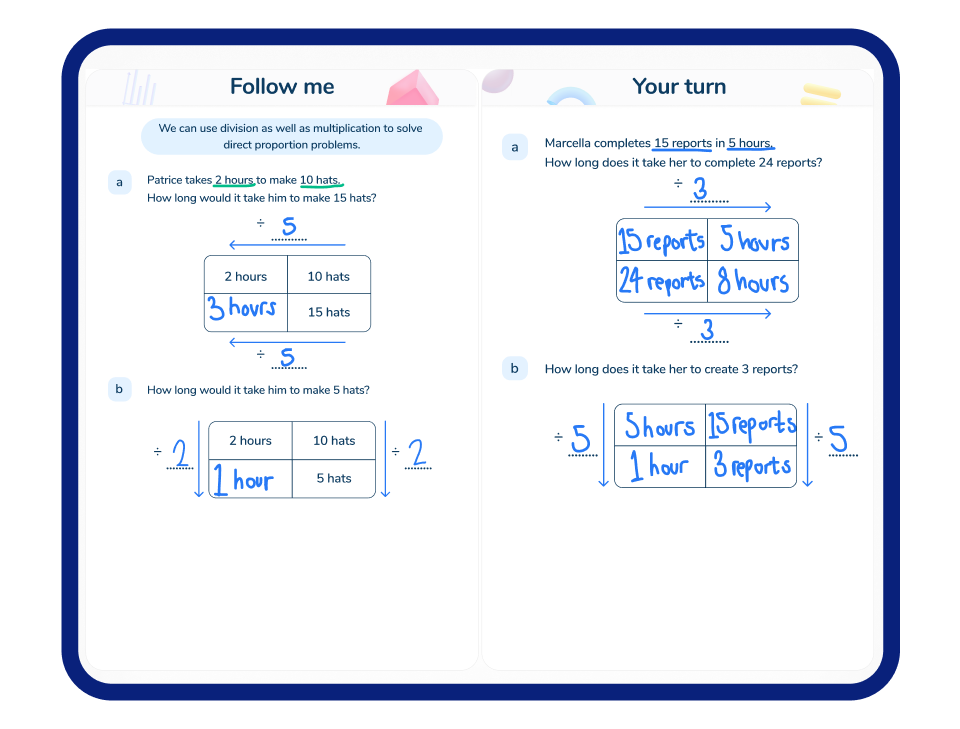
Follow me + your turn
Students work through a scaffolded example with their tutor before trying a similar question on their own
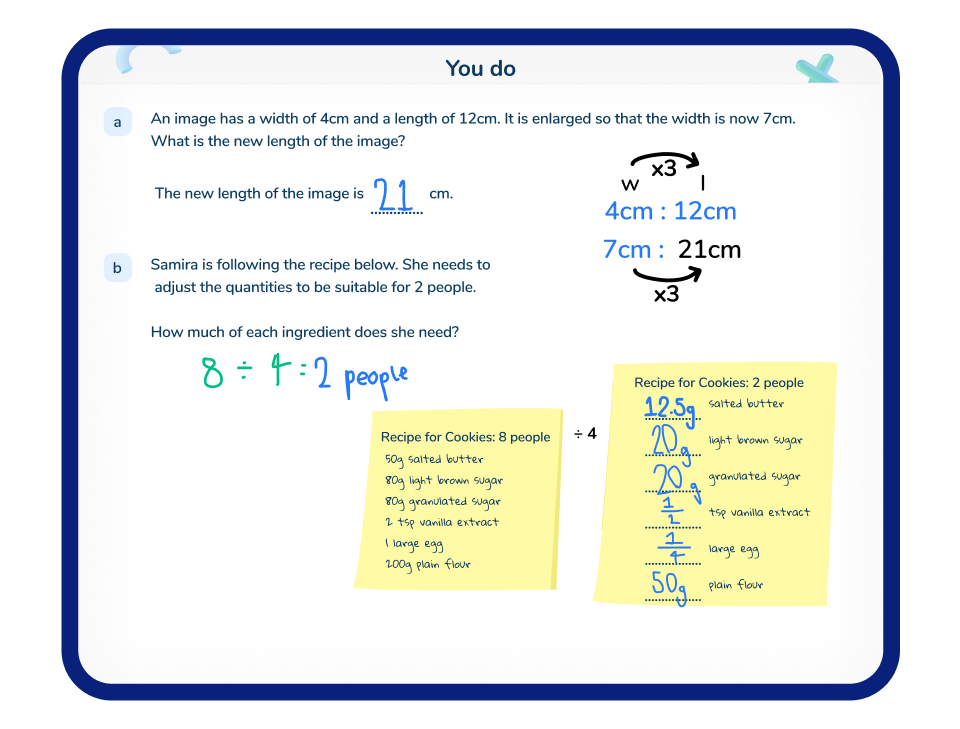
You do
A carefully sequenced next question ensures students can apply knowledge to different contexts
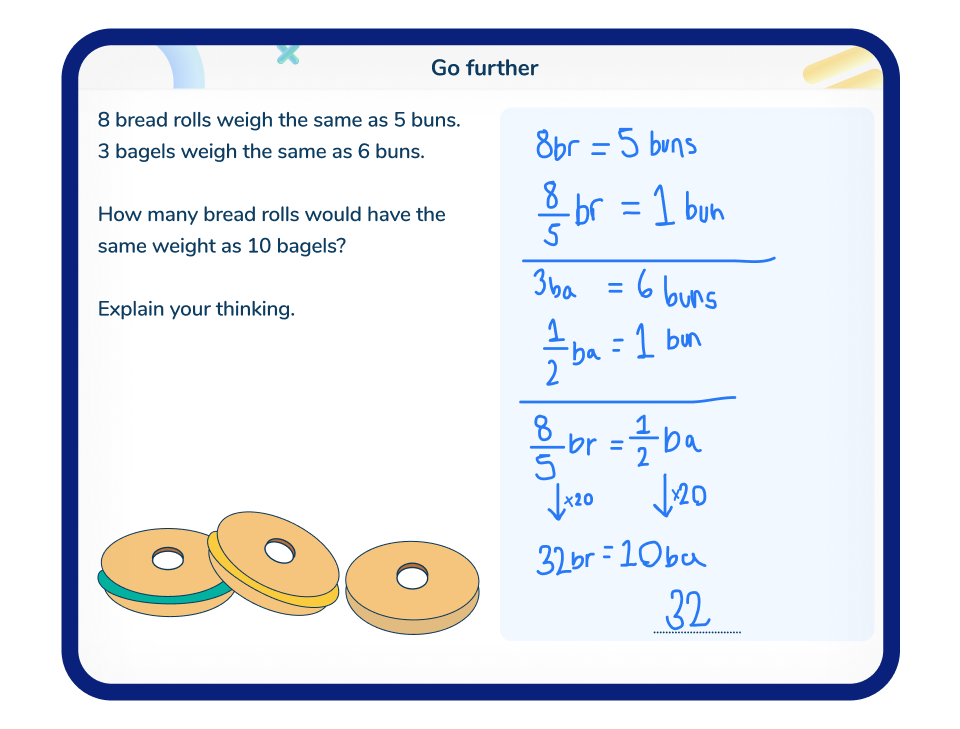
Go further
This gives students an opportunity to apply their knowledge to problem solving and reasoning questions
Understanding multiplying by a negative integer using a number line

Let’s learn
The first question introduces each concept and helps students feel ready to learn
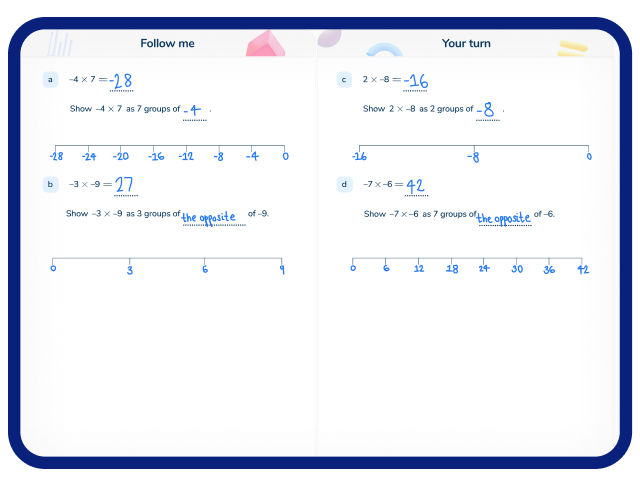
Follow me + your turn
Students work through a scaffolded example with their tutor before trying a similar question on their own
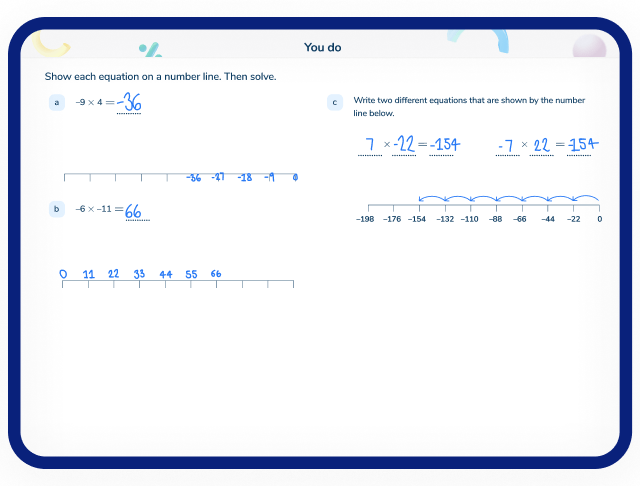
You do
A carefully sequenced next question ensures students can apply knowledge to different contexts
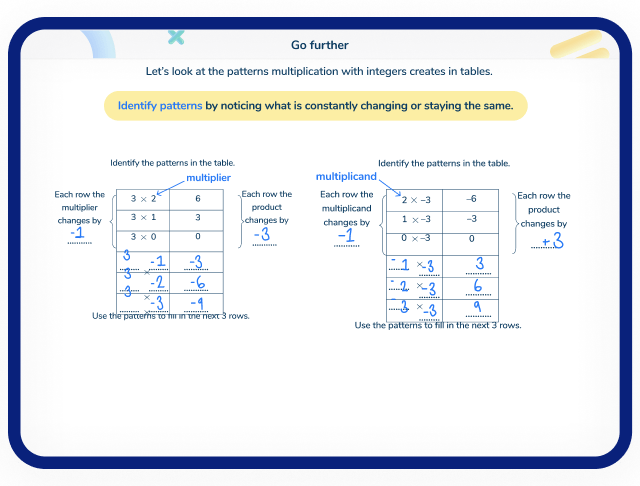
Go further
This gives students an opportunity to apply their knowledge to problem solving and reasoning questions
Factoring linear expressions

Let’s learn
The first question introduces each concept and helps students feel ready to learn
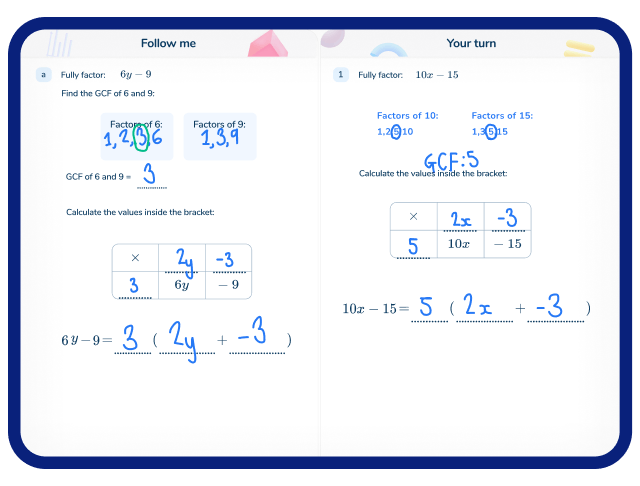
Follow me + your turn
Students work through a scaffolded example with their tutor before trying a similar question on their own
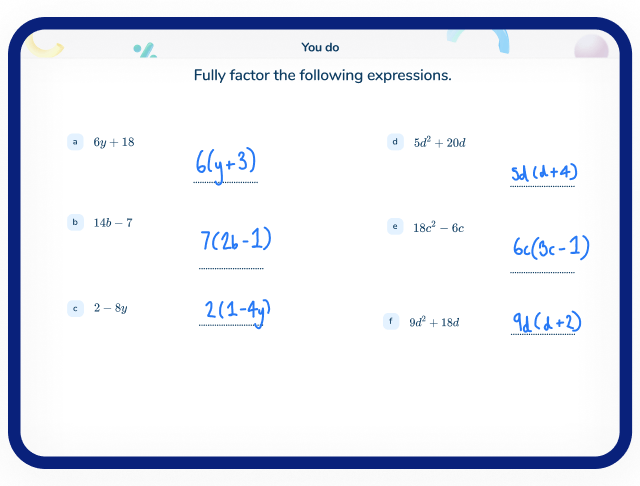
You do
A carefully sequenced next question ensures students can apply knowledge to different contexts
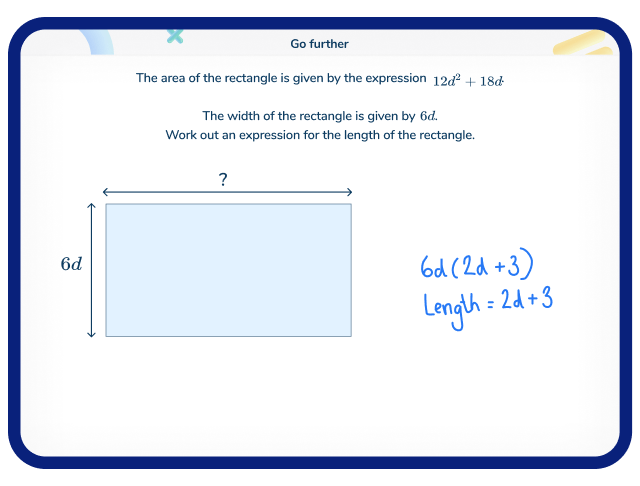
Go further
This gives students an opportunity to apply their knowledge to problem solving and reasoning questions
7th grade scope and sequence
Whether you have students who would benefit from more opportunities to practice 7th grade standards or who have existing gaps from previous grades, we’ve got a program for your 7th grade students.
Click on the program name to view the full scope and sequence.
Whether you have students who would benefit from more opportunities to practice 7th grade standards or who have existing gaps from previous grades, we’ve got a program for your 7th grade students.
Click on the program name to view the full scope and sequence.
7th Grade Program
Best for: Students with gaps from 7th grade
Programme goal: Master 7th grade standards
7th Grade Program
Learning objectives covered in this program:
Third Space Learning lessons are available for all state standards and for Common Core.
Calculating unit rates with fractions
Understanding proportional relationships
Finding the constant of proportionality in tables
Representing proportions with equations
Understanding graphs of proportional relationships
Solving percent of change problems
Solving multi-step proportion problems
Interpreting quantities that combine to zero
Adding integers using number lines
Subtracting integers using integer addition understanding
Adding rational numbers
Subtracting rational numbers
Understanding multiplying by a negative integer using a number line
Applying integer multiplication rules
Understanding integer division by using integer chips
Applying integer division rules
Multiplying rational numbers
Dividing rational numbers
Converting fractions to decimals
Adding and subtracting rational numbers with word problems
Multiplying and dividing rational numbers with word problems
Adding and subtracting linear expressions
Factoring linear expressions
Expanding linear expressions
Identifying equivalent linear expressions
Evaluating numerical expressions involving positive and negative rational numbers
Solving two-step equations
Solving two-step word problems
Comparing solutions
Solving and graphing two-step inequalities
Solving word problems with two-step inequalities
Scaling drawings of polygons
Evaluating changes in scale with perimeter and area related to scale factor
Constructing triangles
Describing cross sections of three-dimensional figures
Understanding measurements of a circle
Using formulas to solve problems with circles
Solving word problems with circles
Solving problems using angle relationships
Evaluating areas of composite shapes
Calculating volume of right prisms and pyramids
Solving real world problems with areas of polygons
Solving real world problems with volume and surface area
Understanding random sampling
Drawing inferences with sample simulations
Informally comparing graphical representations of two populations
Understanding probability of a chance event
Understanding probability through relative frequency
Calculating the theoretical probability of a simple event
Using experimental probability models for unfair events
Creating the sample space of compound events
Finding the probability of a compound event
Creating and using a simulation to generate estimations for compound events
About this program
Lessons focus on securing 7th grade standards to enable students to successfully move on to 8th grade.
How are lessons ordered?
The default order has been set by our academic team to align with your state standards. Schools can pick one of our alternative sequences to re-prioritize domains, or send us their assessment data for us to pick the most appropriate sequence.
Want to speak to our friendly team? Book a call.
6th Grade Program
Best for: Students with gaps from 6th grade
Programme goal: Master 6th grade standards
6th Grade Program
Learning objectives covered in this program:
Third Space Learning lessons are available for all state standards and for Common Core.
Defining and writing ratios
Writing and defining rate and unit rate
Comparing ratios to solve problems
Solving unit rate problems
Using tape diagrams and double number lines ratios
Solving percent problems
Using tables to compare ratios
Converting percents to fractions and decimals
Interpreting quotients of fractions (models)
Finding quotients of fractions using the algorithm
Using the algorithm for division
Adding and subtracting decimals with the algorithm
Multiplying decimals with the algorithm
Dividing decimals with the algorithm
Using models to understand the algorithm
Estimating solutions
Finding GCF of two whole numbers less than or equal to 100
Finding the LCM of two whole numbers less than or equal to 12
Rewriting numerical expressions using distributive property
Interpreting a number and its opposite through real world application
Representing and interpreting rational numbers on the number line
Writing comparison statements for rational numbers
Identifying and interpreting absolute value of rational numbers
Graphing ordered pairs on the coordinate plane
Writing and evaluating expressions with exponents
Reading and writing algebraic expressions
Evaluating algebraic expressions
Identifying and creating equivalent expressions
Using the distributive property
Combining like terms
Interpreting and writing equations
Solving one-step equations
Interpreting and writing inequalities
Solving one-step inequalities
Modeling to solve equations
Using number line to solve equations and inequalities
Identifying and analyzing independent and dependent variables
Using tables to analyze independent and dependent variables
Using graphs to analyze independent and dependent variables
Finding area of triangles
Finding area of quadrilaterals and triangles on the coordinate plane
Finding area of quadrilaterals by decomposing into triangles and rectangles
Finding volume of rectangular prisms with fractional edges
Finding the surface area of prisms and pyramids
Visualizing surface area through nets
Defining and writing statistical questions
Describing the center and spread of dot plot
Calculating mean and median
Creating box plots
Interpreting box plots
Interpreting histograms
Creating histograms
About this program
Lessons focus on securing 6th grade standards to enable students to successfully move on to 7th grade.
How are lessons ordered?
The default order has been set by our academic team to align with your state standards. Schools can pick one of our alternative sequences to re-prioritize domains, or send us their assessment data for us to pick the most appropriate sequence.
Want to speak to our friendly team? Book a call.
5th Grade Program
Best for: Students with gaps from 5th grade
Programme goal: Master 5th grade standards
5th Grade Program
Learning objectives covered in this program:
Third Space Learning lessons are available for all state standards and for Common Core.
Expressions involving parentheses
Evaluating expressions using the order of operations
Interpreting expressions without solving them
Generating numerical patterns given two rules in a real-world situation
Identifying, recording and graphing ordered pairs
Interpreting data using coordinate plane
Reading and writing decimals in numeral, word, and expanded forms
Reading and writing decimals to the thousandths place
Comparing decimals to the hundredths place
Comparing and ordering decimals to the thousandths place
Rounding numbers to the nearest tenth
Rounding numbers to the nearest hundredth
Understanding place value relationships in multi-digit numbers
Multiplying and dividing whole numbers and decimals by 10 and 100
Multiplying and dividing whole numbers and decimals by powers of 10
Finding number pairs that equal 1
Adding and subtracting decimals using known facts
Adding and subtracting tenths and hundredths
Using mental methods to add and subtract whole numbers and decimals
Adding decimals using the standard algorithm
Adding whole numbers and decimals using the standard algorithm
Subtracting whole numbers and decimals using the standard algorithm
Multiplying and dividing decimals using known facts
Multiplying using the partial product method
Multiplying using the standard algorithm
Multiplying whole numbers using the standard algorithm
Dividing using the partial quotient method
Solving problems involving remainders
Solving mixed multiplication and division problems
Finding like denominators to add and subtract fractions
Adding and subtracting fractions with unlike denominators
Adding mixed numbers
Subtracting mixed numbers
Solving word problems involving adding and subtracting fractions with unlike denominators
Using benchmark fractions to estimate and assess reasonableness
Remainders as fractions
Solving word problems with answers as fractions
Finding fractions of a whole number
Multiplying a fraction by a fraction
Multiplying a fraction by a mixed number
Representing fraction products as rectangular areas
Interpreting multiplication as scaling
Solving word problems involving multiplication of fractions and mixed numbers
Solving word problems involving division of a unit fraction by a whole number
Solving word problems involving division of a whole number by a unit fraction
Converting metric units
Converting customary units
Solve problems from a line plot
Finding volume of rectangular prisms
Finding volume of composite shapes
Graphing points on a coordinate plane
Solving problems with points on a coordinate plane
About this program
Lessons focus on securing 5th grade standards to enable students to successfully move on to 6th grade.
How are lessons ordered?
The default order has been set by our academic team to align with your state standards. Schools can pick one of our alternative sequences to re-prioritize domains, or send us their assessment data for us to pick the most appropriate sequence.
Want to speak to our friendly team? Book a call.

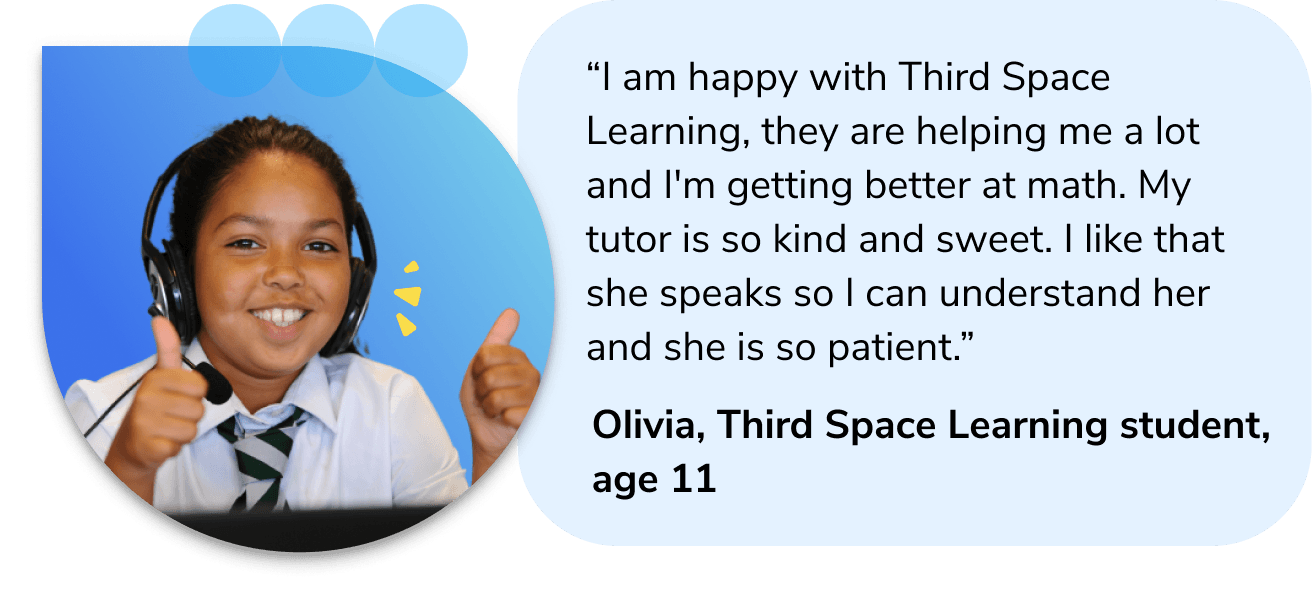
How it works in schools like yours
Personalized one-on-one online math tutoring for multiple students at once, delivered by specialist math tutors at a day and time that works for your school.
Book a free tutoring demo for your school or district
Explore the online classroom, preview lessons aligned to your state’s standards and see for yourself why 4,000+ schools like yours have chosen high impact one-on-one math tutoring from Third Space Learning:
Proven to accelerate math growth in half the time
2.4x cheaper than the average cost of one-on-one tutoring
Scalable and easy-to-implement across multiple grade levels and schools
Flexible scheduling according to your school and district’s needs
You can learn more about how we keep your data safe and secure in our privacy policy.
Frequently asked questions
What type of math do you learn in 7th grade?
In 7th grade, students typically learn to deepen their skills in understanding algebraic expressions, solving more complex equations and inequalities, understanding and applying ratios and proportions, working with integers and rational numbers and exploring more advanced geometry concepts such as proportional relationships.
What is an algebra tutor?
An algebra tutor is a specialized educator who focuses on helping students understand and excel in algebraic thinking and prepare for algenra 1 and algebra 2 in high school. Tutors provide a personalized tutoring experience, including instruction, support, and guidance, to students to improve their algebraic skills.
Is math tutoring worth it?
Math tutoring can be highly beneficial, offering personalized instruction and targeted support at a student’s own pace. This can significantly improve understanding of mathematical concepts, boost confidence and enhance performance in math. By addressing individual learning gaps and challenges, tutoring can offer a tailored teaching experience that might not be achievable in a traditional classroom setting, making it a valuable investment for many students.